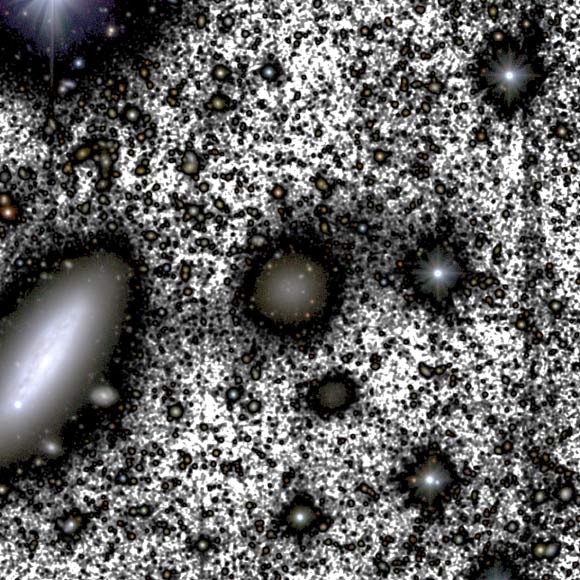Astronomers using the NASA/ESA Hubble Space Telescope have detected tidal tails in NGC 1052-DF4, a dark-matter-deficient galaxy some 65 million light-years away in the constellation of Cetus, caused by its interaction with its neighboring galaxy NGC 1035. The researchers think that a process called tidal disruption stripped the dark matter from NGC 1052-DF4 and is now tearing the galaxy apart.

This Hubble image shows the ultra-diffuse galaxy NGC 1052-DF4; the highlighted objects are globular clusters. Image credit: van Dokkum et al, doi: 10.3847/2041-8213/ab0d92.
Dark matter is a key constituent in current models of galaxy formation and evolution.
In fact, without the presence of dark matter, the primordial gas would lack enough gravity pull to start collapsing and forming new galaxies.
Because this dark matter is thought to interact mostly gravitationally, its presence can only be inferred from its effect on the visible matter.
In 2018, astronomers discovered the first known galaxy without dark matter, NGC 1052-DF2.
A year later, another dark matter-free galaxy was identified, NGC 1052-DF4, which further triggered intense debates among astronomers about the nature of these objects.
In the new study, University of New South Wales astronomer Mireia Montes and colleagues studied NGC 1052-DF4 using deep optical imaging.
They discovered that the missing dark matter can be explained by the effects of tidal disruption.
According to the team, the gravity forces of the neighboring massive galaxy NGC 1035 are tearing NGC 1052-DF4 apart.
During this process, the dark matter is removed, while the stars feel the effects of the interaction with another galaxy at a later stage.
“We used Hubble in two ways to discover that NGC 1052-DF4 is experiencing an interaction,” Dr. Montes said.
“This includes studying the galaxy’s light and distribution of globular clusters.”

This image presents the region around the galaxy NGC 1052-DF4, taken by the IAC80 telescope at the Teide Observatory in Tenerife. The image shows the main galaxies in the field-of-view, including NGC 1052-DF4 (center of the image), and its massive neighbor NGC 1035 (center left). Image credit: Montes et al., doi: 10.3847/1538-4357/abc340.
By studying the galaxy’s light, the astronomers found evidence of tidal tails, which are formed of material moving away from NGC 1052-DF4 — this further supports the conclusion that this is the tidal disruption process.
They also found the central parts of the galaxy remain untouched and only 7% of the stellar mass of the galaxy is hosted in these tidal tails.
This means that dark matter, which is less concentrated than stars, was previously and preferentially stripped from the galaxy, and now the outer stellar component is starting to be stripped as well.
“This result is a good indicator that, while the dark matter of the galaxy was evaporated from the system, the stars are only now starting to suffer the disruption mechanism,” said Dr. Ignacio Trujillo, an astronomer at the Instituto de Astrofísica de Canarias.
“In time, NGC 1052-DF4 will be cannibalized by the large system around NGC 1035, with at least some of their stars floating free in deep space.”
The findings are published in the Astrophysical Journal.
_____
Mireia Montes et al. 2020. The Galaxy “Missing Dark Matter” NGC 1052-DF4 is Undergoing Tidal Disruption. ApJ 904, 114; doi: 10.3847/1538-4357/abc340







